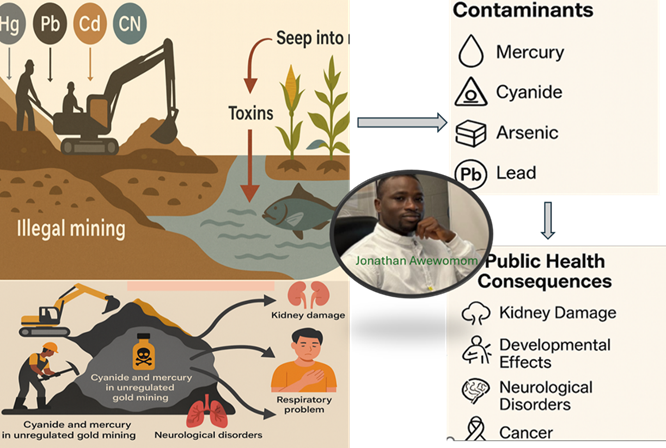The Galamsey Chronicles: Illegal Mining and the Fate of a Nation: (Episode 1/10)


A Nation Being Poisoned: The Human Cost of Galamsey
Ghana has always been celebrated for its rich soils, rivers, and gold-laden hills a land of abundance. But today, that abundance is being turned against us. Illegal artisanal mining, known locally as galamsey, has become more than an economic or environmental challenge; it is slowly becoming a form of chronic poisoning of the Ghanaian population.
This is not rhetoric, it is chemistry. A poison is any substance that, when introduced into the body in sufficient amounts, disrupts normal biological processes and causes harm. Some poisons act quickly, cyanide, for instance, can stop cellular respiration in minutes, but others work silently over years, quietly damaging organs until the harm is irreversible. The tragedy of galamsey is that it is not just polluting our rivers or stripping our forests; it is leaving behind an invisible trail of toxicants that are accumulating in our bodies, our soils, and our food chain.
Galamsey as a Slow-Acting Poison
What makes galamsey so dangerous is that its effects are not instant. When miners use mercury to amalgamate gold, the mercury does not simply disappear, it seeps into water bodies, is converted into methylmercury by microorganisms, and accumulates in fish that end up on our dinner tables. Chronic exposure to methylmercury is well documented to cause neurological damage, developmental delays in children, and cardiovascular problems.
Cyanide, another common chemical used by “Galamseyers” to extract gold, is acutely toxic in high doses but also has subtler chronic effects. Low-level exposure has been linked to thyroid dysfunction and neurological symptoms. Arsenic and lead, frequently released when soils are disturbed, are known carcinogens and can lead to kidney damage, anemia, and impaired brain development. These are not distant, theoretical risks. Studies from mining areas in Ghana have reported elevated levels of these contaminants in soil, water, and human blood samples.
Yet, unlike infectious diseases where symptoms appear rapidly, chemical poisoning is insidious. A farmer may drink contaminated water for years before kidney disease develops. A child may inhale dust laced with lead or arsenic for a decade before cognitive effects are noticed. By the time illness is diagnosed, the link to galamsey is often missed, leaving the root cause unaddressed.
Galamsey is silently poisoning Ghanaians; contaminating the water we drink, the food we eat, and even the air we breathe toxicants such as mercury, cyanide, arsenic, and lead that slowly destroy our health over years before the damage becomes visible
The Hidden Burden on Public Health
Because the effects are delayed, Ghana’s health system rarely attributes cases of chronic liver disease, kidney failure, or developmental disorders directly to illegal mining. But epidemiological studies globally have shown strong links: Mercury exposure correlates with tremors, memory loss, and birth defects. Arsenic exposure is associated with skin and bladder cancers, and cardiovascular diseases. Lead exposure reduces IQ in children and increases the risk of hypertension in adults.
If these associations hold true elsewhere, why should Ghana be exempt? The absence of comprehensive long-term monitoring does not mean the problem does not exist; it simply means we are flying blind while the damage continues. The cost is enormous, not just in hospital bills but in lost productivity, shortened lifespans, and reduced national competitiveness as more citizens suffer preventable illnesses.
A Governance and Justice Question
The chronic poisoning of Ghanaians is therefore not only a health issue, but also a governance challenge.
- Do we have systems in place to test water quality in mining districts regularly?
- Are there biomonitoring programs to measure contaminants in communities at risk?
- Where is the accountability for those from illegal operators to complicit officials whose activities are leaving Ghanaians with a lifelong health bill?
- Do we have the mechanisms to bring to justice the miners, financiers, and enablers whose actions are silently harming entire populations?
When these systems fail, we normalize slow violence against our population. The right to safe water and a healthy environment is a constitutional guarantee, not a luxury. Every gallon of contaminated water that reaches a household, every bag of cocoa laced with mercury that is exported, is a failure of national stewardship.
Toward a National Reflection
The first step is acknowledgment. Ghana must admit that galamsey is not just about pits and excavators it is about the biochemistry of survival. We need:
- Systematic monitoring of mercury, arsenic, cyanide, and lead levels in mining communities.
- Public health surveillance to detect clusters of chronic disease that may be environmentally linked.
- Education campaigns so that communities understand the long-term risks, not just the short-term cash.
- Stronger enforcement not just at the pit, but at the financial and political levels where galamsey is enabled.
This is not a call to demonize miners, many are driven by poverty and unemployment, but a call to halt the chronic national poisoning.
The Human Cost
If left unchecked, galamsey will continue to erode not just our environment but our health, our economy, and our future. The chronic chemical poisoning of Ghanaians is a quiet emergency. It does not scream like a flood or an earthquake, but it steals potential year after year, silently draining the strength of our nation.
Ghana must decide: will we allow this slow poisoning to continue, or will we put a stop to it? The answer will determine whether future generations inherit a country capable of sustaining life or merely the toxic remains of what once was.
DISCLAIMER: The Views, Comments, Opinions, Contributions and Statements made by Readers and Contributors on this platform do not necessarily represent the views or policy of Multimedia Group Limited.
DISCLAIMER: The Views, Comments, Opinions, Contributions and Statements made by Readers and Contributors on this platform do not necessarily represent the views or policy of Multimedia Group Limited.
Source link





